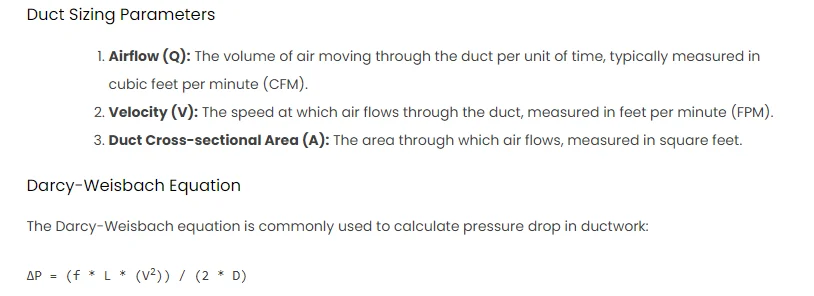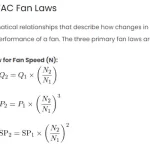HVAC ductwork equations are mathematical formulas that relate various parameters of duct design and performance, such as air flow, velocity, friction, pressure, and heat transfer. These equations are useful for sizing and selecting ducts, as well as calculating the energy efficiency and operating costs of HVAC systems.
Basic Theory
Duct Sizing Parameters
- Airflow (Q): The volume of air moving through the duct per unit of time, typically measured in cubic feet per minute (CFM).
- Velocity (V): The speed at which air flows through the duct, measured in feet per minute (FPM).
- Duct Cross-sectional Area (A): The area through which air flows, measured in square feet.
Darcy-Weisbach Equation
The Darcy-Weisbach equation is commonly used to calculate pressure drop in ductwork:
ΔP = (f * L * (V2)) / (2 * D)
Where:
ΔPis the pressure drop,fis the Darcy friction factor,Lis the duct length,Vis the air velocity,Dis the hydraulic diameter of the duct.
Procedures
- Step 1: Determine Airflow Requirements
- Step 2: Select Duct Size
- Step 3: Calculate Duct Cross-sectional Area:
- Step 4: Determine Hydraulic Diameter:
- Step 5: Calculate Pressure Drop using the Darcy-Weisbach Equation
Scenario: Office Space HVAC Design
Let’s consider an office space with the following parameters:
- Required Airflow (Q): 2,000 CFM
- Duct Length (L): 100 feet
- Desired Air Velocity (V): 800 FPM
Excel Calculation
Create an Excel table with the following columns:
- Airflow (Q)
- Air Velocity (V)
- Duct Cross-sectional Area (A)
- Hydraulic Diameter (D)
- Pressure Drop (
)
Perform the calculations in each row according to the equations mentioned above.
MATLAB Comparison
Write a MATLAB script to perform the same calculations and compare the results with Excel.
% MATLAB Script
Q = 2000; % Airflow in CFM
L = 100; % Duct Length in feet
V = 800; % Air Velocity in FPM
A = Q / V; % Duct Cross-sectional Area
D = (4 * A) / pi; % Hydraulic Diameter
% Darcy-Weisbach Equation
f = 0.02; % Assume a friction factor
pressureDrop = (f * L * (V^2)) / (2 * D);


